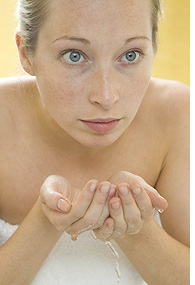by Peggy Altman
 As an esthetician, I see many people who wish their skin could look better without a lot of cost and effort. To brighten your facial skin, you need to get back to the basics. The most expensive products in the world won’t work optimally unless these four simple steps are taken care of: cleansing, toning, moisturizing and, during the day, using sunscreen.
As an esthetician, I see many people who wish their skin could look better without a lot of cost and effort. To brighten your facial skin, you need to get back to the basics. The most expensive products in the world won’t work optimally unless these four simple steps are taken care of: cleansing, toning, moisturizing and, during the day, using sunscreen.
Cleansing
There are a lot of misconceptions about this step. Skin should be cleansed twice a day: morning and night. If you can only do it once, do so at night so that you get the pollution off your face instead of keeping it on your skin all night and rubbing it into your pillow! Do your nighttime facial skin care routine at least 30 minutes before going to bed. You want the products you use to absorb into your skin, not into your pillow case.
Use the right cleansing product for your skin type. There’s a lot of misunderstanding about dry versus dehydrated skin.
- Dry skin has very small pores and produces little oil on its own.
- Oily skin has larger pores and produces more oil, particularly during the teenage years.
- Dehydrated skin lacks water.
People can have skin that is dry, yet feels oily under certain conditions. For example, if you have small pores but work in a fast-food kitchen, your skin may feel oily due to the environment. But you should still use a cleanser for dry skin. Likewise, a woman with oily skin (large pores) that feels dehydrated to the touch should still use a cleanser for oily skin, which is more effective at cleaning the larger pores.
Cleansers are usually labeled by skin type. In general, creamy cleaners are for dry skin, and gels and foams are for oilier skin. Bar soaps – even those that say “extra gentle” or “dermatologist recommended” – are usually too harsh for facial skin. If your skin feels squeaky clean after washing, your cleanser is too harsh.
Wash your face over the sink, not in a shower. Most of us shower in water that is too hot for facial skin. Also, our facial skin is delicate, so we should avoid the shower’s water pressure.
Toning
This is an easy step: use any non-alcohol-based toning product. Nothing expensive. Toner helps reset the pH level of the skin, which helps prevent bacteria from growing. It also removes residual cleanser from the face.
Moisturizing
All skin types need to be moisturized, although as we age we may need stronger ingredients. Even oily skin gets dehydrated, especially in winter.
Like cleansers, moisturizers are usually labeled by skin type. But you also need to take into account how your skin feels. Remember the example of the person with dry skin who works in a fast-food kitchen? A moisturizer for oily skin would be a better choice for the days she works, and one for dry skin on her days off.
Moisturizers that work well in the summer may not be strong enough for the winter. Store your “off-season” products in the refrigerator, or use them on your neck.
Sunscreen
Sunscreen is currently the most effective anti-aging product there is. Many moisturizers have sunscreen as an added ingredient. If yours does, consider using a sunscreen-free product at nighttime to lessen the amount of chemicals on your skin. If you are going to be in the sun for an extended period, use a sunscreen-only product over your moisturizer. If you use a powder foundation or blush, put the sunscreen on before the powder to prevent a paste from forming over your makeup.
These are the basics! If you’ve been skipping any of these steps, your skin may not be as bright as it could be.
Peggy Altman is a licensed esthetician, licensed massage therapist, and meditation teacher. She has an office in Tuckahoe, NY, and can be reached at (914) 262-6397. Visit Peggy’s website at www.aheavenlyretreat.com to find out more about her services.




